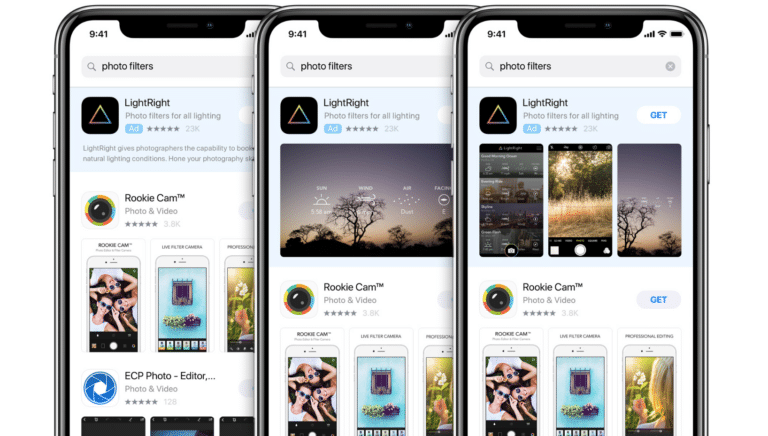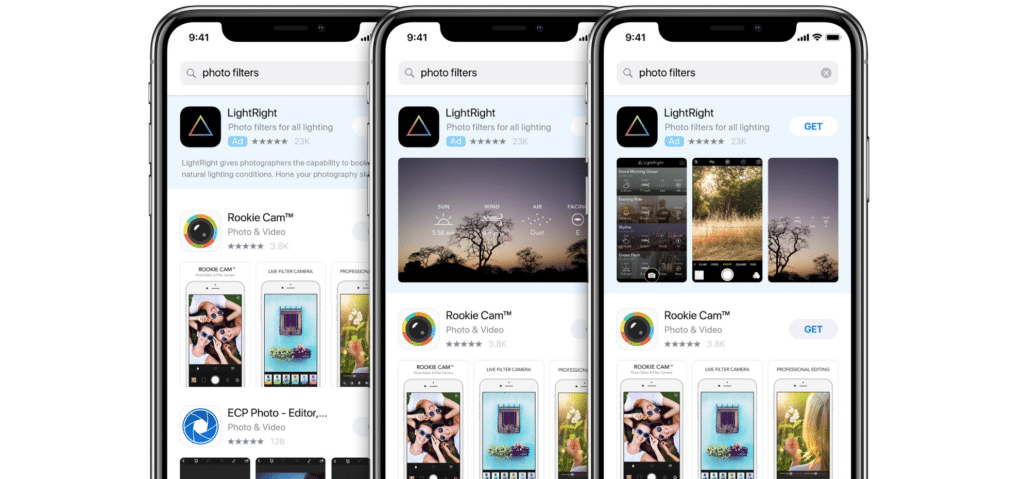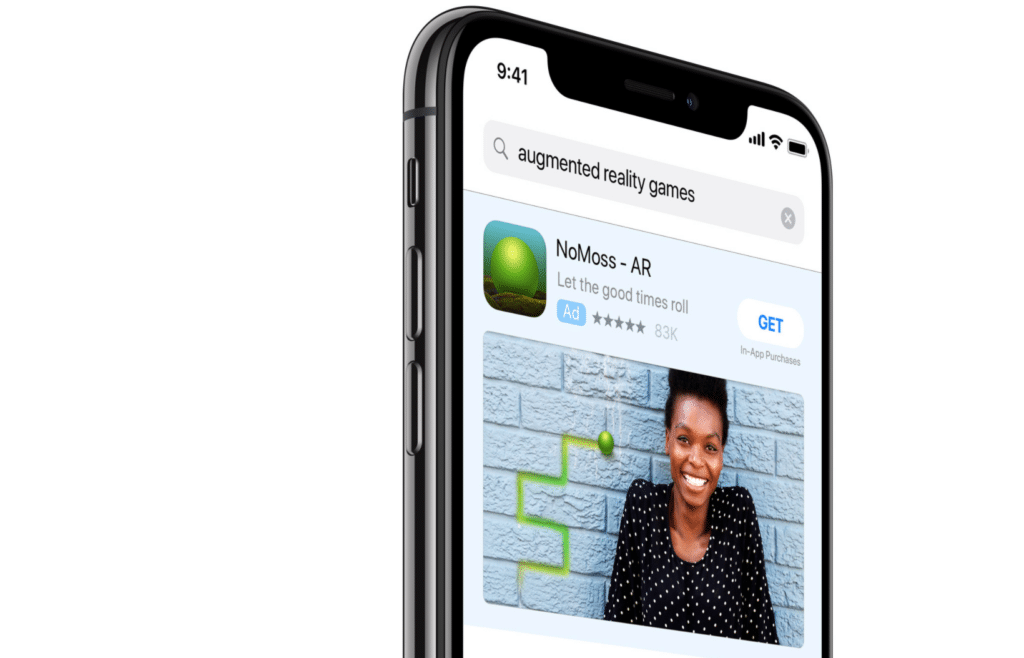Most—if not all—mobile marketers have at least considered adding Apple Search Ads to their mobile marketing growth stacks. Now that we’re in 2018 and the effects of Apple Search Ads campaigns are on full display, growth marketing professionals across industries and around the globe are seeing the value of investing marketing spend into this increasingly influential channel.
The logic of investing mobile marketing dollars and time into Apple Search Ads as a channel of mobile user acquisition isn’t too difficult to see. After all, Apple recently reported that a startling 65% of mobile app downloads come directly from a search on the Apple App Store, while Search Ads maintain an impressive average mobile user conversion rate of 50% and while brands reportedly see 30% higher average revenues among mobile users acquired via Apple Search Ads over mobile users acquired via other mobile ad platforms.
Furthermore, the opportunity to grow your mobile app’s user acquisition rate through Apple Search Ads is currently available to all mobile marketers and developers with mobile apps on the App Store for either iPhone or iPad in more countries than ever before—the U.S., UK, Canada, Australia, New Zealand, Mexico, or Switzerland; countries that do not have a dedicated App Store default to the U.S. App Store.
Assuming you’re on the hunt for mobile users in these countries, investing in Apple Search Ads seems like a no-brainer, right? Sure—but there are tools and strategies behind truly optimized Apple Search Ads campaign management that will allow you to rise above these already impressive results and extract even more revenue (and therefore mobile marketing-driven ROI). To learn more, keep reading or request a Branch demo.
Select Search Ads Campaign Keywords and Negative Keywords Wisely
Perhaps implied by its name, Apple Search Ads depend on the selection of relevant keywords to be highly effective drivers of app downloads in 2018. The goal, of course, is to select simultaneously popular and relevant campaign keywords (based on both your mobile app and your ideal app downloaders), and to select negative keywords that will keep every search relevant.
First, let’s review the types of Apple Search Ad campaigns—exact matches show your ad if and only if a given user’s search models your keywords exactly, while broad matches will present after taking into account what Apple refers to as “close variants of a keyword”, including singular/plural shifts, tense shifts, misspellings, and more. In contrast, search matches allow Apple to decide (based on your app’s metadata) for which keywords your app is sufficiently relevant. Exact matches generally sport the highest TTRs but lowest impression rates, while search matches generally sport the highest impression rates but lowest TTRs; broad matches generally (perhaps logically) produce TTRs and impression rates that fall in-between those of exact matches and search matches. Choosing the correct type of keyword modeling given your goals and Search Ad priorities can make all the difference.
It’s also critical to address how keywords and negative keywords work together to make sure you’re targeting App Store users with the greatest intent and relevance to your mobile app. While keywords are terms for which you want your Search Ads to present, negative keywords are terms for which you don’t want Search Ads to present. For instance, if a keyword for your mobile app is “online doctor”, a negative keyword would be “online”.
In terms of actually finding high performing keywords for Apple Search Ads, I’ve got some good news for those who have already mastered ASO: generally, the same keywords that are relevant from an ASO standpoint will be relevant from an Apple Search Ads standpoint. If you haven’t yet mastered the art of optimizing your mobile app for the App Store, consider checking out Emily Grossman’s Branchout talk, “Attract the Right Customers with Strategic App Store Optimization”.
Implement Search Ads Campaign Keywords Strategically
You should first ensure that Apple will deem your ad campaign (and, more generally, your iOS app) relevant to your desired set of keywords. Apple renders Search Ads campaigns eligible or ineligible based on your mobile app’s metadata, so aligning the keywords you select with the components of your app’s metadata—among them, your app name and App Store app description—is key.
In general, adding the search terms for which you want your app to appear can only help, especially since the creative assets you use for your mobile app are the creative assets used for your Search Ads. Because Apple logically wants to present only highly relevant ads to App Store users searching for apps, completing this step is a necessary prerequisite for optimizing the reach and overall effectiveness of Apple Search Ads.
Optimize Your Search Ads’ TTR (Tap-Through-Rate)
One might assume that Apple takes the highest bidder for a given keyword search and presents this ad—while this may be logical in the short term, this is actually false. Ultimately, Apple is interested in presenting ads that are the most likely to be clicked (and therefore drive more revenue for Apple), so maximizing TTR (or tap-through-rate) is essential for boosting your Search Ads’ impression frequency.
Since Apple Search Ads that begin with low TTRs are de-prioritized in Apple’s selection of Search Ads to present to App Store users, it’s most important to begin Apple Search Ad campaigns with content that will deliver a high tap-through-rate. In addition to adding negative keywords, there are a couple of ways one can concretely move to optimize TTR rates prior to the onset of a Search Ads campaign.
If you’re stuck trying to improve TTR, consider taking measures to increase your app’s App Store rating by offering those who provide an in-app rating of your app with the opportunity to review your app in the App Store. Additionally, it’s important to read (and listen to) app reviews while attracting beta testers for app updates to make sure any and all necessary improvements are sorted out prior to release to the App Store public. Finally, as mentioned above, Search Ads campaigns that implement exact matches tend to receive more relevant impressions, and thus tend to boast higher tap-through rates.
All of this is to say, the app who bids the most is not necessarily the app who will win the placement—if you find that your mobile app is not winning bids and you’ve already tried raising your big price, it may be time to reevaluate both your app’s metadata as well as the keywords on which you’re bidding, while executing some of the above measures to assuredly raise your app’s tap-through-rate.
Leverage Attribution that Gives You the Full Story
When measuring the success of an Apple Search Ads campaign (or, really, any promotion-based acquisition campaign in this day and age), the more complete a pre- and post-install story you can tell about app users acquired via Apple Search Ads, the better. Given that walled gardens—isolated mobile channels and platforms that aim to keep users as well as data to themselves—are fighting more tenaciously than ever, it’s critical to leverage actionable cross-channel, cross-platform attribution data that can connect each and all of these user interactions.
If you’re like 95% of mobile professionals in 2018, you’re juggling a plethora of campaigns across channels—in addition to investing in Apple Search Ads, you’re likely investing in Facebook, Adwords, LinkedIn or Twitter, native ads, press, app cross-promotion, incentivized installs and referrals, and a whole host of additional channels. Legacy attribution providers limit the data you’re able to access for critical budgeting and decision making to the sole last-touch data they report. In doing so, legacy attribution providers are failing to provide the full, often complicated portrait of your app’s mobile user acquisition performance.
For example, suppose your latest app user downloaded your app via an Apple Search Ad that Apple served to him or her after viewing an ad for your app in his or her Facebook newsfeed three days prior. While most attribution providers would assign sole credit to the App Store, Branch’s Attribution Solution Engine will recognize and connect these sessions by the user they share.
In 2018’s cross-platform world, you need an analytics solution that will prevent you from overinvesting in last-touch acquisition channels while underinvesting in first-touch mobile user acquisition channels that may well deliver extensive ROI. Ultimately, Branch’s Attribution Solution gives you the power to connect touchpoints from every channel with conversions on any platform. If your interest is piqued, you can learn how Nextdoor saw 77% increase in attributed installs with Attribution Solution. For a more technical review of how Branch can help you measure your Apple Search Ad campaigns by fetching attribution data from Apple at the point of app install, you can click here.
Let Data Guide Your Apple Search Ad Mobile Strategy and Execution
Finally, it is important to remember to actively measure Apple Search Ad performance (and overall mobile user acquisition performance, for that matter) in both the short-term and the long-term, and to consult both sets of data before making any important decisions based on the health of your Apple Search Ads. If you’re seeing short-term fluctuation in the performance of your Apple Search Ads, zoom out. The mobile user acquisition data you’ve collected in the long-term will clue you into whether a sudden (or even gradual) dip or spike could be the result of a change in paid acquisition performance or an external stimulus like, for instance, a holiday.
Above all, it’s critical to remember that the key to mobile marketing growth in 2018 is swift data-driven decision making—and optimizing the performance of your Apple Search Ad campaigns is no different. More data is never a bad thing. Digest it—whether it is or is not the news you were hoping to hear—and let it propel the growth of your mobile app into subsequent quarters of 2018 and beyond.
To learn more about Apple Search Ads, check out Splitmetrics’ “All Things Apple Search Ads” conference from April 11-12. You’ll hear from 13+ Apple Search Ads experts who will help you navigate the sea of metrics, strategies, and tactics to optimize the performance of your latest ASA campaigns. There will be live Q&A sessions, panel discussions, and live webinars from leading industry experts.
Our co-founder Mada Seghete will be sharing her best strategies for Apple Search Ads campaign management, optimization, and measurement. Click here to register for the free two-day conference.


























